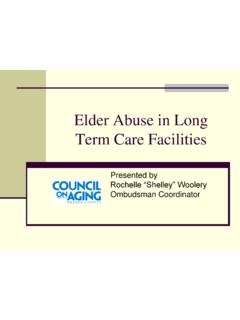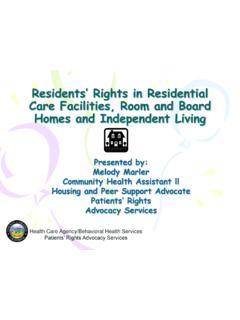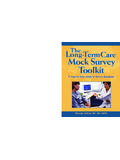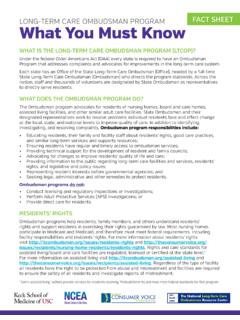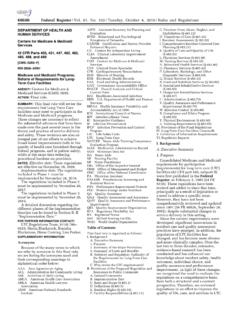Transcription of Confronting Elder Mistreatment in Long-Term Care
1 REVIEW. Confronting Elder Mistreatment in Long-Term care Lisa M. Gibbs, MD, and Laura Mosqueda, MD. Elder Mistreatment has a devastating METHODS. impact on its victims and is associat- ed with increased mortality rates. There are few research publications regarding Elder Mistreatment in Elderly persons residing in residen- Long-Term care settings. Material for this review was gathered by vari- tial care facilities are vulnerable due ous methods. These include a Pub Med review of search terms that to decreased ability for self- care and include: Elder abuse and risk factors, Elder abuse and Long-Term medical illnesses affecting cognitive care , Elder abuse and institution, Elder abuse and assisted living and physical function.
2 Markers for facility, and Elder abuse and board and care . Inclusion criteria neglect such as pressure ulcers, mal- included all original research publications with a focus on Elder abuse nutrition, and dehydration may be and Long-Term care . A recent publication, Elder Mistreatment by the falsely attributed to natural conse- National Research Council, was reviewed as an expert Given quences of declining health. Re- the paucity of literature, unpublished material from professional expe- search and education regarding rience and communication was also utilized.
3 Markers of Mistreatment are needed for early recognition and interven- tion. In addition, effective commu- BACKGROUND. nication between care providers and residents with dementia helps to Federal legislation against nursing home abuse was included in the avert aggressive behaviors that pre- Omnibus Budget Reconciliation Act of 1987 (OBRA 87). Types of cipitate physical and verbal abuse . Elder Mistreatment in nursing homes, residential care facilities (RCF), Long-Term care providers must be and assisted living facilities include neglect, and physical, psychological, vigilant in looking for markers of financial, and sexual abuse .
4 Elder abuse is associated with increased Mistreatment and must report sus- morbidity and mortality Some researchers believe that Elder pected cases so that elderly persons abuse in institutional care is a common part of institutional life, . are protected, abusers are identi- rather than isolated, noteworthy Elder abuse is estimated to fied, and facility care is improved. affect at least 3-4%4 of our nation's seniors and 13% of community- (Annals of Long-Term care : Clinical dwelling persons referred to health and social service Deter- care and Aging 2004;12[4]:30-35) mining the true incidence and prevalence of Elder abuse is difficult due to underreporting, varying definitions, and lack of uniform processes Dr.
5 Gibbs is assistant clinical pro- among reporting agencies. In addition, various states have different fessor of Family Medicine, and Dr. Mosqueda is associate professor of reporting methods and requirements. Administration on Aging (AoA). Clinical Family Medicine and direc- data from 2001 show that there are 63,433 licensed Long-Term care tor of the Program in Geriatrics, facilities with million beds. This includes nursing and board-and- University of California, Irvine, care facilities . Over the past five years, the number of nursing facilities College of Medicine; Orange, CA.
6 Has declined by 3% to 17,710, while the number of board-and- care 30 Annals of Long-Term care / Volume 12 , Number 4 / April 2004. Elder Mistreatment . facilities has risen by to 45,723. Nationally, Vulnerability results from dependency on caregivers there were 90 complaints per 1,000 Long-Term care due to chronic medical illnesses, especially those that beds. Of these, there were complaints of abuse , affect cognition. A 1999 national survey revealed that gross neglect, or exploitation per 1000 nursing home 32% of the residents living in nursing facilities beds, and complaints per 1,000 board-and- care required assistance with four activities of daily living It should be noted that these numbers repre- (ADLs), and 75% required assistance with at least sent complaints, not substantiated cases of mistreat- three Moreover, since Adult Protective Ser- ment.
7 These numbers do not include complaints vice use is an independent risk factor for placement related to chemical and physical restraints or pressure into a nursing facility,13 many residents in nursing sores. The Waxman report revealed that one out of homes may have already experienced Elder abuse every three nursing homes was cited for physical, sex- prior to placement and continue to be at risk. ual, or verbal abuse throughout a two-year period. Studies continue to provide evidence that persons Over 9% of U. S.
8 Nursing homes were cited for abuse with dementia carry a high risk for Mistreatment . that caused actual harm, placed residents in serious One study surveyed persons calling a dementia danger, or resulted in significant injury or helpline and found that 12% of the caregivers had Definitive incidence and prevalence data are lack- physically abused the demented persons in their ing. Regulatory agencies that oversee nursing homes A nine-year observational cohort study of have annual survey data, but no such data from other community-dwelling seniors found that cognitive Long-Term care facilities are Elder mis- impairment, and specifically, the onset of a new cog- treatment remains both underreported and underrec- nitive impairment was an associated risk factor for ognized, particularly by healthcare providers9 such as Elder The prevalence of cognitive physicians and nurses.
9 In addition, Long-Term care problems among nursing home residents is very high: residents and their families are In 42-66% of the elderly population living in facilities one survey, 95% of the residents interviewed noted have a significant cognitive In addi- that they have either been a victim of neglect or wit- tion, many may experience adverse effects from nessed someone else being polypharmacy, infections, and dehydration; all of Surveys of nursing facility staff reveal that abuse is these may contribute to delirium.
10 These numbers common. One study noted that 36% of the staff had leave no doubt that Long-Term care facilities harbor a witnessed an episode of physical abuse and 81% had group of seniors who are particularly vulnerable to witnessed psychological abuse over a one-year peri- Mistreatment . Physical abuse was defined as excessive use of Multiple authors have shown that persons with restraints as well as multiple types of physical aggres- behavioral problems are at higher risk for abuse . One sion. Psychological abuse included isolating, insult- study of nursing home staff revealed that aggressive ing, swearing at, yelling, and threatening a patient.
